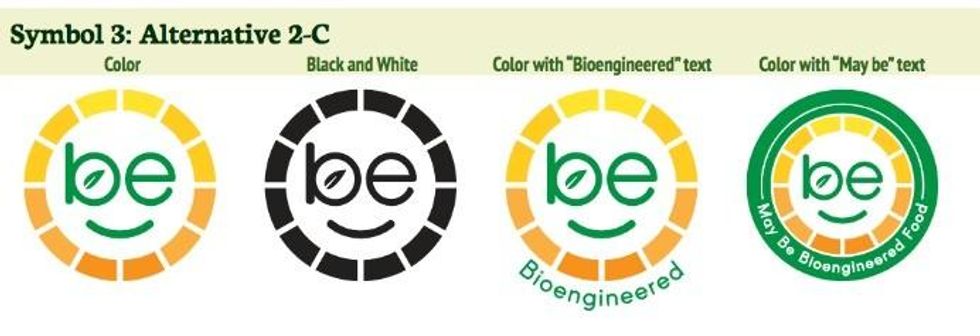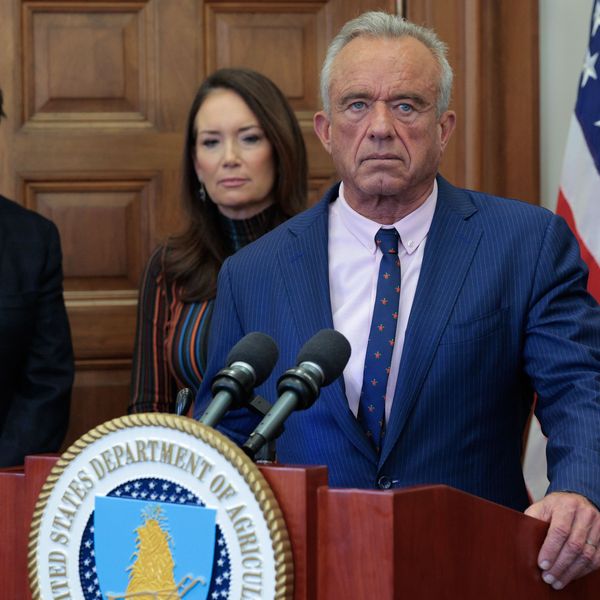
These are among the USDA's proposed symbols for foods produced using genetic engineering.
Trump's USDA Proposes Deceptively Cute Images for GMO Labels, But Nixes the Words 'Genetically Modified'
"The images are just as insulting to consumers as the law, which the chemical and junk food industry lobbyists spent $400 million to pass," says Katherine Paul of the Organic Consumers Association
The public comment period is now open on the U.S. Department of Agriculture's just unveiled proposal for food labeling of products using GMOs--a plan that would have labels without the words "genetically modified" or "genetically engineered," but instead adorned with cheerful images.
According to Wenonah Hauter, executive director of Food & Water Watch, the proposal represents "a gift to industry from our now Secretary of State, Mike Pompeo, who authored the legislation to squash the Vermont GMO labeling law and mandatory labels."
The proposal follows President Barack Obama's 2016 signature on an industry-approved bill--dubbed the DARK Act--that required national labeling standard rules, and which critics blasted for having loopholees and lacking a mandate for adequate GMO labels. That law, which pre-empted Vermont's first-of-its-kind labeling law, also required a deadline for the final rules by July 29, 2018, hence the USDA's rollout this week.
Among the problems with the proposal, says Hauter, is that the "rule refers to GMOs as 'bioengineered,' or BE foods. This is a deceptive strategy because most consumers don't know what that means."
Andrew Kimbrell, executive director at Center for Food Safety, agreed, saying, "USDA's exclusion of the well-established terms, GE and GMO, as options will confuse and mislead consumers, and the agency must instead allow the use of those terms."
As for the images that will bear the acronym BE--"Wait 'till you see them," writes Katherine Paul, associate director of the Organic Consumers Association. "All bright and cheery, with sunburst and smiley-faced images--but without 'GMO' appearing anywhere on the labels."
\u201cYOU'VE GOT TO BE KIDDING ME! Check out these @USDA proposed "keep consumers in the dark" labels! #DarkAct #GMOs #GMOLabeling #Food https://t.co/78IKUr8S6d\u201d— Organic Consumers Association (@Organic Consumers Association) 1525457074
"The images are just as insulting to consumers as the law, which the chemical and junk food industry lobbyists spent $400 million to pass--under the specious name of the 'Safe and Affordable Food Labeling Act,'" Paul said.
The problems go beyond the symbol, say food safety groups.
"One of the many loopholes," Hauter added, is that it "would allow a company that knowingly sells canned GMO sweetcorn to use a label that says 'may be bioengineered' because less than 85 percent of sweetcorn grown is genetically engineered."
In addition, it would allow companies to use electronic QR codes, instead of a clear symbol, which would necessitate consumers having a clear internet connection, a smart phone, and the time for the hassle it would take to scan them.
"USDA should not allow QR codes," Kimbrell said bluntly. "USDA's own study found that QR codes are inherently discriminatory against one third of Americans who do not own smartphones, and even more so against rural, low income, and elderly populations or those without access to the internet. USDA should mandate on-package text or symbol labeling as the only fair and effective means of disclosure for GE foods."

In sum, the groups say, the proposal leaves consumers in the dark.
"This is a 'Call to Action' to all Americans who have waited for decades to finally have GE foods labeled," says Kimbrell. "Now is the time to tell the Trump administration to do the right thing and meaningfully label these foods."
An Urgent Message From Our Co-Founder
Dear Common Dreams reader, The U.S. is on a fast track to authoritarianism like nothing I've ever seen. Meanwhile, corporate news outlets are utterly capitulating to Trump, twisting their coverage to avoid drawing his ire while lining up to stuff cash in his pockets. That's why I believe that Common Dreams is doing the best and most consequential reporting that we've ever done. Our small but mighty team is a progressive reporting powerhouse, covering the news every day that the corporate media never will. Our mission has always been simple: To inform. To inspire. And to ignite change for the common good. Now here's the key piece that I want all our readers to understand: None of this would be possible without your financial support. That's not just some fundraising cliche. It's the absolute and literal truth. We don't accept corporate advertising and never will. We don't have a paywall because we don't think people should be blocked from critical news based on their ability to pay. Everything we do is funded by the donations of readers like you. Will you donate now to help power the nonprofit, independent reporting of Common Dreams? Thank you for being a vital member of our community. Together, we can keep independent journalism alive when it’s needed most. - Craig Brown, Co-founder |
The public comment period is now open on the U.S. Department of Agriculture's just unveiled proposal for food labeling of products using GMOs--a plan that would have labels without the words "genetically modified" or "genetically engineered," but instead adorned with cheerful images.
According to Wenonah Hauter, executive director of Food & Water Watch, the proposal represents "a gift to industry from our now Secretary of State, Mike Pompeo, who authored the legislation to squash the Vermont GMO labeling law and mandatory labels."
The proposal follows President Barack Obama's 2016 signature on an industry-approved bill--dubbed the DARK Act--that required national labeling standard rules, and which critics blasted for having loopholees and lacking a mandate for adequate GMO labels. That law, which pre-empted Vermont's first-of-its-kind labeling law, also required a deadline for the final rules by July 29, 2018, hence the USDA's rollout this week.
Among the problems with the proposal, says Hauter, is that the "rule refers to GMOs as 'bioengineered,' or BE foods. This is a deceptive strategy because most consumers don't know what that means."
Andrew Kimbrell, executive director at Center for Food Safety, agreed, saying, "USDA's exclusion of the well-established terms, GE and GMO, as options will confuse and mislead consumers, and the agency must instead allow the use of those terms."
As for the images that will bear the acronym BE--"Wait 'till you see them," writes Katherine Paul, associate director of the Organic Consumers Association. "All bright and cheery, with sunburst and smiley-faced images--but without 'GMO' appearing anywhere on the labels."
\u201cYOU'VE GOT TO BE KIDDING ME! Check out these @USDA proposed "keep consumers in the dark" labels! #DarkAct #GMOs #GMOLabeling #Food https://t.co/78IKUr8S6d\u201d— Organic Consumers Association (@Organic Consumers Association) 1525457074
"The images are just as insulting to consumers as the law, which the chemical and junk food industry lobbyists spent $400 million to pass--under the specious name of the 'Safe and Affordable Food Labeling Act,'" Paul said.
The problems go beyond the symbol, say food safety groups.
"One of the many loopholes," Hauter added, is that it "would allow a company that knowingly sells canned GMO sweetcorn to use a label that says 'may be bioengineered' because less than 85 percent of sweetcorn grown is genetically engineered."
In addition, it would allow companies to use electronic QR codes, instead of a clear symbol, which would necessitate consumers having a clear internet connection, a smart phone, and the time for the hassle it would take to scan them.
"USDA should not allow QR codes," Kimbrell said bluntly. "USDA's own study found that QR codes are inherently discriminatory against one third of Americans who do not own smartphones, and even more so against rural, low income, and elderly populations or those without access to the internet. USDA should mandate on-package text or symbol labeling as the only fair and effective means of disclosure for GE foods."

In sum, the groups say, the proposal leaves consumers in the dark.
"This is a 'Call to Action' to all Americans who have waited for decades to finally have GE foods labeled," says Kimbrell. "Now is the time to tell the Trump administration to do the right thing and meaningfully label these foods."
The public comment period is now open on the U.S. Department of Agriculture's just unveiled proposal for food labeling of products using GMOs--a plan that would have labels without the words "genetically modified" or "genetically engineered," but instead adorned with cheerful images.
According to Wenonah Hauter, executive director of Food & Water Watch, the proposal represents "a gift to industry from our now Secretary of State, Mike Pompeo, who authored the legislation to squash the Vermont GMO labeling law and mandatory labels."
The proposal follows President Barack Obama's 2016 signature on an industry-approved bill--dubbed the DARK Act--that required national labeling standard rules, and which critics blasted for having loopholees and lacking a mandate for adequate GMO labels. That law, which pre-empted Vermont's first-of-its-kind labeling law, also required a deadline for the final rules by July 29, 2018, hence the USDA's rollout this week.
Among the problems with the proposal, says Hauter, is that the "rule refers to GMOs as 'bioengineered,' or BE foods. This is a deceptive strategy because most consumers don't know what that means."
Andrew Kimbrell, executive director at Center for Food Safety, agreed, saying, "USDA's exclusion of the well-established terms, GE and GMO, as options will confuse and mislead consumers, and the agency must instead allow the use of those terms."
As for the images that will bear the acronym BE--"Wait 'till you see them," writes Katherine Paul, associate director of the Organic Consumers Association. "All bright and cheery, with sunburst and smiley-faced images--but without 'GMO' appearing anywhere on the labels."
\u201cYOU'VE GOT TO BE KIDDING ME! Check out these @USDA proposed "keep consumers in the dark" labels! #DarkAct #GMOs #GMOLabeling #Food https://t.co/78IKUr8S6d\u201d— Organic Consumers Association (@Organic Consumers Association) 1525457074
"The images are just as insulting to consumers as the law, which the chemical and junk food industry lobbyists spent $400 million to pass--under the specious name of the 'Safe and Affordable Food Labeling Act,'" Paul said.
The problems go beyond the symbol, say food safety groups.
"One of the many loopholes," Hauter added, is that it "would allow a company that knowingly sells canned GMO sweetcorn to use a label that says 'may be bioengineered' because less than 85 percent of sweetcorn grown is genetically engineered."
In addition, it would allow companies to use electronic QR codes, instead of a clear symbol, which would necessitate consumers having a clear internet connection, a smart phone, and the time for the hassle it would take to scan them.
"USDA should not allow QR codes," Kimbrell said bluntly. "USDA's own study found that QR codes are inherently discriminatory against one third of Americans who do not own smartphones, and even more so against rural, low income, and elderly populations or those without access to the internet. USDA should mandate on-package text or symbol labeling as the only fair and effective means of disclosure for GE foods."

In sum, the groups say, the proposal leaves consumers in the dark.
"This is a 'Call to Action' to all Americans who have waited for decades to finally have GE foods labeled," says Kimbrell. "Now is the time to tell the Trump administration to do the right thing and meaningfully label these foods."

